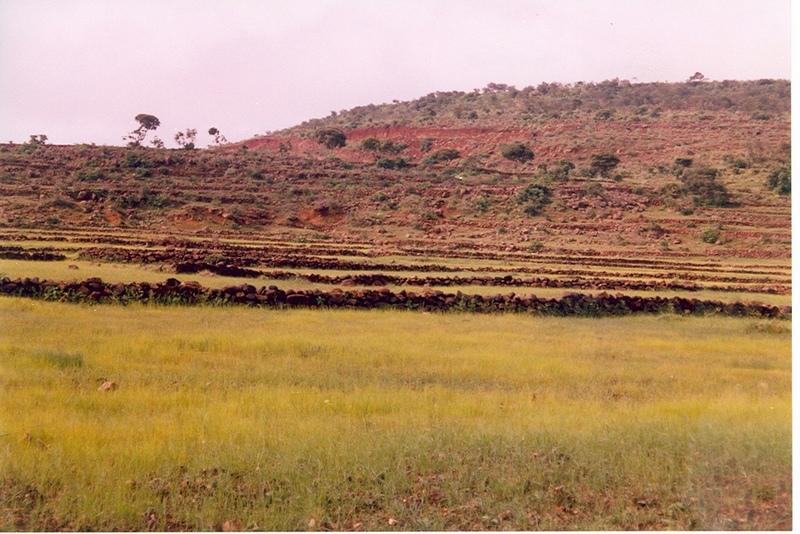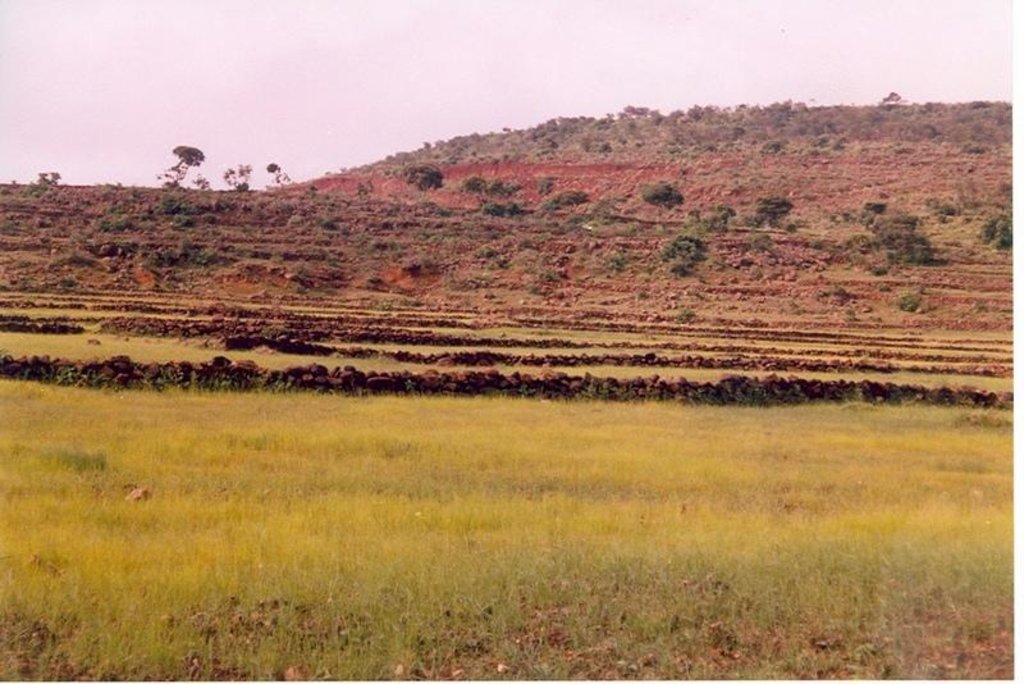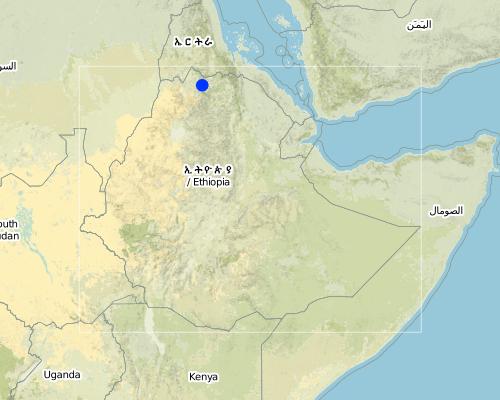Stone faced trench bund [Ethiopia]
- Creation:
- Update:
- Compiler: Unknown User
- Editor: –
- Reviewer: Fabian Ottiger
Emni Getsel metrebawizala
technologies_991 - Ethiopia
View sections
Expand all Collapse all1. General information
1.2 Contact details of resource persons and institutions involved in the assessment and documentation of the Technology
Key resource person(s)
SLM specialist:
Dawit Michael
Ministry of Agriculture and Natural Resources
Adet Naedir woreda office of agriculture and natural resources, Adet Naeder, Tigray, Ethiopia
Ethiopia
Name of the institution(s) which facilitated the documentation/ evaluation of the Technology (if relevant)
Ministry of Agriculture and Natural Resources of Ethiopia (MoA) - Ethiopia1.3 Conditions regarding the use of data documented through WOCAT
The compiler and key resource person(s) accept the conditions regarding the use of data documented through WOCAT:
Ja
2. Description of the SLM Technology
2.1 Short description of the Technology
Definition of the Technology:
It is an allignment of stones embankment at the lower/downslope of the trench dug to form earth embankment following a contour.
2.2 Detailed description of the Technology
Description:
Description: digging of foundation, stone wall constructionof 60-80 m, digging of trench along the contour Purpose: decrease soil erosion, moisture harvesting, decrease slope length, reduce runoff velocity and increase productivity per unit area Establishment/Maintenance: planting of fodder trees and integrate with biological measures Environment: enhance to grow natural grasses and vegetation, minimize desertification, recharge ground water and improve local climate
2.3 Photos of the Technology
2.5 Country/ region/ locations where the Technology has been applied and which are covered by this assessment
Country:
Ethiopia
Region/ State/ Province:
Tigray
Further specification of location:
Adet Naedir
Map
×2.6 Date of implementation
If precise year is not known, indicate approximate date:
- more than 50 years ago (traditional)
2.7 Introduction of the Technology
Specify how the Technology was introduced:
- through projects/ external interventions
Comments (type of project, etc.):
Developed in the region
3. Classification of the SLM Technology
3.2 Current land use type(s) where the Technology is applied

Cropland
- Annual cropping
Main crops (cash and food crops):
Major cash crop: Teff, maize, sorghum
Major food crop: Lentile, flux, niger seed, beans

Forest/ woodlands
Products and services:
- Timber
- Fuelwood
- Grazing/ browsing
- Nature conservation/ protection
Comments:
Major land use problems (compiler’s opinion): Decline of soil fertility and productivity, soil erosion, deforestation, overgrazing
Major land use problems (land users’ perception): Decrease in production, low moisture content of the soil, drought and deforestation
Plantation forestry: deforestation
Problems / comments regarding forest use: Basically the forest land is open wood/shrub cover and used for grazing/browsing at the same time
Ge: Extensive grazing land
3.3 Further information about land use
Water supply for the land on which the Technology is applied:
- rainfed
Number of growing seasons per year:
- 1
Specify:
Longest growing period in days: 120Longest growing period from month to month: Jun - Oct
3.4 SLM group to which the Technology belongs
- cross-slope measure
3.5 Spread of the Technology
Comments:
Total area covered by the SLM Technology is 32 m2.
This data is based on the Adet Naedir office of Agriculture and Natural Resources
3.6 SLM measures comprising the Technology

agronomic measures
- A6: Others
Comments:
Main measures: structural measures
Secondary measures: agronomic measures, vegetative measures
Type of agronomic measures: better crop cover, manure / compost / residues, mineral (inorganic) fertilizers, contour tillage
Type of vegetative measures: aligned: -contour
3.7 Main types of land degradation addressed by the Technology

soil erosion by water
- Wt: loss of topsoil/ surface erosion
- Wg: gully erosion/ gullying

chemical soil deterioration
- Ca: acidification
Comments:
Main type of degradation addressed: Wt: loss of topsoil / surface erosion
Secondary types of degradation addressed: Wg: gully erosion / gullying, Ca: acidification
3.8 Prevention, reduction, or restoration of land degradation
Specify the goal of the Technology with regard to land degradation:
- reduce land degradation
- restore/ rehabilitate severely degraded land
Comments:
Main goals: mitigation / reduction of land degradation
Secondary goals: rehabilitation / reclamation of denuded land
4. Technical specifications, implementation activities, inputs, and costs
4.2 Technical specifications/ explanations of technical drawing
Technical knowledge required for field staff / advisors: moderate
Technical knowledge required for land users: low
Main technical functions: control of dispersed runoff: retain / trap, increase / maintain water stored in soil
Secondary technical functions: reduction of slope length, increase of infiltration, water harvesting / increase water supply
Better crop cover
Material/ species: teff, sorghum
Agronomic measure: row planting
Material/ species: maize
Quantity/ density: 45,000/ha
Remarks: planting on rows along the contour
Contour tillage
Remarks: farmers plow their land along the contour
Aligned: -contour
Vegetative material: T : trees / shrubs, G : grass
Number of plants per (ha): 100-150
Vertical interval between rows / strips / blocks (m): 1m
Spacing between rows / strips / blocks (m): 20-25m
Vertical interval within rows / strips / blocks (m): 2.5 m
Width within rows / strips / blocks (m): 1
Trees/ shrubs species: leucanea, sesbanea
Grass species: local grasses
Slope (which determines the spacing indicated above): 12.00%
Gradient along the rows / strips: 12.00%
Bund/ bank: level
Vertical interval between structures (m): 1
Spacing between structures (m): 20-25m
Depth of ditches/pits/dams (m): 0.3m
Width of ditches/pits/dams (m): 0.5m
Height of bunds/banks/others (m): 0.5-0.75m
Width of bunds/banks/others (m): 1m
Length of bunds/banks/others (m): 60-80m
Structural measure: bund / bank: level
Vertical interval between structures (m): 1m
Spacing between structures (m): 20-25m
Height of bunds/banks/others (m): 0.5-0.75m
Width of bunds/banks/others (m): 0.5-0.75m
Length of bunds/banks/others (m): 0.5-0.75m
Slope (which determines the spacing indicated above): 12%
Lateral gradient along the structure: 0%
Vegetation is used for stabilisation of structures.
4.3 General information regarding the calculation of inputs and costs
other/ national currency (specify):
Birr
Indicate exchange rate from USD to local currency (if relevant): 1 USD =:
8.0
Indicate average wage cost of hired labour per day:
0.88
4.4 Establishment activities
| Activity | Type of measure | Timing | |
|---|---|---|---|
| 1. | seedling production | Vegetative | Dec.-June |
| 2. | seedling planting | Vegetative | June-July |
| 3. | collection of stones | Management | dry season |
| 4. | placing of stones | Management | dry season |
| 5. | digging of trench | Management | dry season |
| 6. | embanking of soil | Management | dry season |
4.5 Costs and inputs needed for establishment
| Specify input | Unit | Quantity | Costs per Unit | Total costs per input | % of costs borne by land users | |
|---|---|---|---|---|---|---|
| Labour | Labour | ha | 1.0 | 118.0 | 118.0 | 100.0 |
| Equipment | Animal traction | ha | 1.0 | 20.0 | 20.0 | 100.0 |
| Equipment | Tools | ha | 1.0 | 2.0 | 2.0 | 100.0 |
| Plant material | Seeds | ha | 1.0 | 6.25 | 6.25 | 100.0 |
| Fertilizers and biocides | Fertilizer | ha | 1.0 | 33.75 | 33.75 | 100.0 |
| Other | Other cost | ha | 1.0 | 17.5 | 17.5 | 100.0 |
| Total costs for establishment of the Technology | 197.5 | |||||
Comments:
Duration of establishment phase: 48 month(s)
4.6 Maintenance/ recurrent activities
| Activity | Type of measure | Timing/ frequency | |
|---|---|---|---|
| 1. | plowing | Agronomic | March-July / 3-4 times |
| 2. | sowing | Agronomic | June-July / Once |
| 3. | Weeding | Agronomic | July-August / twice |
| 4. | harvest | Agronomic | Oct.-Dec. / once |
| 5. | Replanting | Vegetative | July /once |
4.7 Costs and inputs needed for maintenance/ recurrent activities (per year)
| Specify input | Unit | Quantity | Costs per Unit | Total costs per input | % of costs borne by land users | |
|---|---|---|---|---|---|---|
| Labour | Labour | ha | 1.0 | 10.5 | 10.5 | 100.0 |
| Total costs for maintenance of the Technology | 10.5 | |||||
Comments:
Machinery/ tools: crawbar, hammer, shovel, digging hoe
length of the structure and tree seedlings per hectar
4.8 Most important factors affecting the costs
Describe the most determinate factors affecting the costs:
labour, slope
5. Natural and human environment
5.1 Climate
Annual rainfall
- < 250 mm
- 251-500 mm
- 501-750 mm
- 751-1,000 mm
- 1,001-1,500 mm
- 1,501-2,000 mm
- 2,001-3,000 mm
- 3,001-4,000 mm
- > 4,000 mm
Specify average annual rainfall (if known), in mm:
550.00
Agro-climatic zone
- sub-humid
- semi-arid
Semi arid covers larger area
5.2 Topography
Slopes on average:
- flat (0-2%)
- gentle (3-5%)
- moderate (6-10%)
- rolling (11-15%)
- hilly (16-30%)
- steep (31-60%)
- very steep (>60%)
Landforms:
- plateau/plains
- ridges
- mountain slopes
- hill slopes
- footslopes
- valley floors
Altitudinal zone:
- 0-100 m a.s.l.
- 101-500 m a.s.l.
- 501-1,000 m a.s.l.
- 1,001-1,500 m a.s.l.
- 1,501-2,000 m a.s.l.
- 2,001-2,500 m a.s.l.
- 2,501-3,000 m a.s.l.
- 3,001-4,000 m a.s.l.
- > 4,000 m a.s.l.
Comments and further specifications on topography:
Landforms: Hill slopes coer a larger area of the woreda but there are also footslopes and plateaus/plains
Slopes on average: Also Rolling and moderate
5.3 Soils
Soil depth on average:
- very shallow (0-20 cm)
- shallow (21-50 cm)
- moderately deep (51-80 cm)
- deep (81-120 cm)
- very deep (> 120 cm)
Soil texture (topsoil):
- medium (loamy, silty)
Topsoil organic matter:
- medium (1-3%)
- low (<1%)
If available, attach full soil description or specify the available information, e.g. soil type, soil PH/ acidity, Cation Exchange Capacity, nitrogen, salinity etc.
Soil depth on average: Also very shallow and moderately deep
Soil texture: Also coarse/light and fine/heavy
Soil fertility is low. Also very low and medium
Topsoil organic matter: Low (this data is based of physical observation on crop performance)
Soil drainage/infiltration is medium. Also good and poor
Soil water storage capacity is low. Also medium, very low.
5.6 Characteristics of land users applying the Technology
Market orientation of production system:
- subsistence (self-supply)
Off-farm income:
- less than 10% of all income
Relative level of wealth:
- poor
- average
Level of mechanization:
- manual work
- animal traction
Indicate other relevant characteristics of the land users:
Population density: 100-200 persons/km2
Annual population growth: 2% - 3%; 3%
10% of the land users are rich and own 15% of the land.
40% of the land users are average wealthy and own 45% of the land.
30% of the land users are poor and own 25% of the land.
20% of the land users are poor and own 15% of the land.
Off-farm income specification: daily labourer in town, food for work
Level of mechanization: Manual labour and animal traction (oxen plow)
5.7 Average area of land owned or leased by land users applying the Technology
- < 0.5 ha
- 0.5-1 ha
- 1-2 ha
- 2-5 ha
- 5-15 ha
- 15-50 ha
- 50-100 ha
- 100-500 ha
- 500-1,000 ha
- 1,000-10,000 ha
- > 10,000 ha
Comments:
Cropland: Average land holding is 0.5 ha.
Forest/woodland per household: 0.5- 1 ha (most of the forest/bush lands are owned communally, but some farmers owned their own woodlots, 0.25ha per household)
5.8 Land ownership, land use rights, and water use rights
Land ownership:
- state
Land use rights:
- open access (unorganized)
- individual
6. Impacts and concluding statements
6.1 On-site impacts the Technology has shown
Socio-economic impacts
Production
crop production
fodder production
fodder quality
wood production
production area
land management
Income and costs
farm income
workload
Socio-cultural impacts
community institutions
national institutions
SLM/ land degradation knowledge
Ecological impacts
Soil
soil moisture
Comments/ specify:
Can lead to waterlogging
soil cover
soil loss
Other ecological impacts
Biodiversity
Soil fertility
Increased input constraints
6.2 Off-site impacts the Technology has shown
reliable and stable stream flows in dry season
downstream flooding
downstream siltation
6.4 Cost-benefit analysis
How do the benefits compare with the establishment costs (from land users’ perspective)?
Short-term returns:
positive
Long-term returns:
very positive
How do the benefits compare with the maintenance/ recurrent costs (from land users' perspective)?
Short-term returns:
positive
Long-term returns:
positive
6.5 Adoption of the Technology
Comments:
100% of land user families have adopted the Technology without any external material support
109035 land user families have adopted the Technology without any external material support
Comments on spontaneous adoption: survey results
There is a moderate trend towards spontaneous adoption of the Technology
Comments on adoption trend: some individual farmers are applying the technology on their farm land by their own.
6.7 Strengths/ advantages/ opportunities of the Technology
| Strengths/ advantages/ opportunities in the land user’s view |
|---|
|
increase in productivity How can they be sustained / enhanced? continous maintenance, |
|
increase soil fertility How can they be sustained / enhanced? integrate biological SWC measures |
|
increase fodder availability How can they be sustained / enhanced? planting of fooder trees and grass species on the enbankments |
| Strengths/ advantages/ opportunities in the compiler’s or other key resource person’s view |
|---|
|
decrease soil erosion How can they be sustained / enhanced? By integrating area closure on the up slopes and incorporate biological SWC |
| moisture harvesting |
| increase production |
| enhance vegetation growth |
| decrease runoff velocity |
6.8 Weaknesses/ disadvantages/ risks of the Technology and ways of overcoming them
| Weaknesses/ disadvantages/ risks in the land user’s view | How can they be overcome? |
|---|---|
| loss of cultivated land | increase the land productivity by incorporating biological measures in the system |
| Weaknesses/ disadvantages/ risks in the compiler’s or other key resource person’s view | How can they be overcome? |
|---|---|
| labour intensive | mobilization of the community |
| hinder farm operation | enlarge the spacing between bunds |
Links and modules
Expand all Collapse allLinks
No links
Modules
No modules




